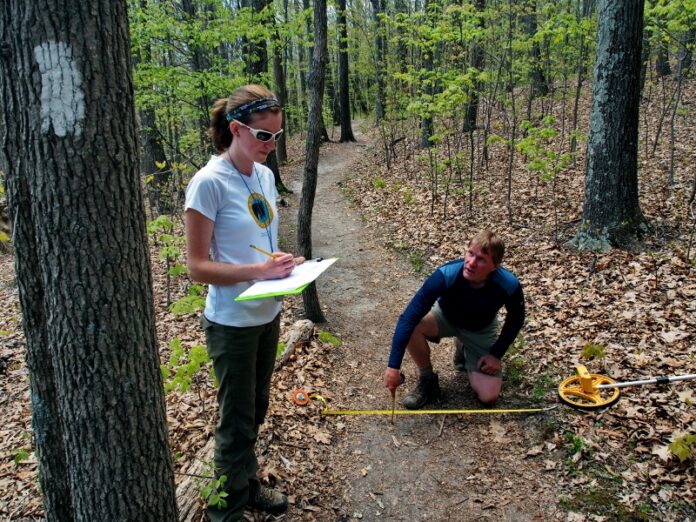
More than 2 million visitors a year hike on the Appalachian Trail, from short hikes on day visits to months-long escapes as they traverse the sometimes rugged expanse from Georgia to Maine. The impact of their recreational experiences on the natural resources along the way is largely unknown.
In 2015, a U.S. Geological Survey researcher will lead a team from Virginia Tech and North Carolina State University to create the most comprehensive data set about trail and campsite conditions in the Appalachian National Scenic Trail’s more than 90-year history.
Jeff Marion, adjunct professor of natural resource recreation in Virginia Tech’s College of Natural Resources and Environment and a recreation ecologist with the U.S. Geological Survey, has received a $300,000 grant from the National Park Service to characterize visitor impacts on vegetation and soils, develop sustainability guidance to minimize impacts, provide workshops on trail design for maintenance staff and volunteers, and provide education materials about Leave No Trace practices and outdoor ethics for schools, youth groups, and trail users.
Marion has been hiking 100-mile sections of the Appalachian Trail most years for several decades and has completed all but 188 miles of the 2,180-mile trail. He observed that the trail becomes steeper and rockier as he has hiked south to north, and the sustainability of its design has declined.
“Trails in the Northeast — New Hampshire, Vermont, Massachusetts, and Maine — were largely created by early hikers, not designed by trail professionals, so they tend to go straight up and down slopes rather than weave across the landscape, which is a more sustainable design,” Marion observed.
“On the other hand, the north is heavily glaciated, exposing a lot of rock. It is reasonably durable, but constructing sustainable trail is more difficult,” he added.
However, even the durable rocky trails have seen dramatic changes in recent years. Many Vermont trails and even roads were wiped out by Tropical Storm Irene in August 2011.
“With climate change, I believe there will be more catastrophic climate events, such as heavy and extended rain events that really stress trails,” said Marion. “We need to create more sustainably designed trails that will handle these rain events as well as increasing traffic.”
“The diversity of terrain and climate will be challenges to collecting data,” he continued.
Marion will be assisted by his former graduate student Jeremy Wimpey, who received his doctorate in geospatial and environmental analysis from Virginia Tech in 2009 and with whom Marion first drafted a proposal to assess the Appalachian Trail. Wimpey has since started his own trail consulting company, Applied Trails Research.
Current geospatial and environmental analysis doctoral student Holly Eagleston ofWenatchee, Washington, will lead the field research for the project. Yu-Fai Leung, Marion’s first graduate student who earned a doctorate in forestry in 1998 and is now a professor of parks, recreation, and tourism management at North Carolina State University, and Leung’s graduate student, Kaitlin Burroughs, are also research partners.
The field survey work will apply a comprehensive set of measurements to assess the conditions and sustainability of the trail tread, shelters, and campsites, creating a comprehensive, spatially referenced database to conduct statistical modeling and geographic information system analyses.
The Appalachian Trail is managed by the National Park Service in collaboration with other federal and state land management agencies through a unique partnership with the Appalachian Trail Conservancy and 30 Appalachian Trail clubs. For example, the Outdoor Club at Virginia Tech maintains 30 miles of the Appalachian Trail.
“I will be working with knowledgeable members from each club as I do the research and will give workshops with the clubs on trail design, camping management, and low-impact practices,” Marion said.
“The research results will be able to be applied immediately to improve the sustainability of trails and overnight camping,” he continued. “The National Park Service wants to ensure that the clubs have the information they need for science-based trail and campsite design and management.”
– Lynn Davis


